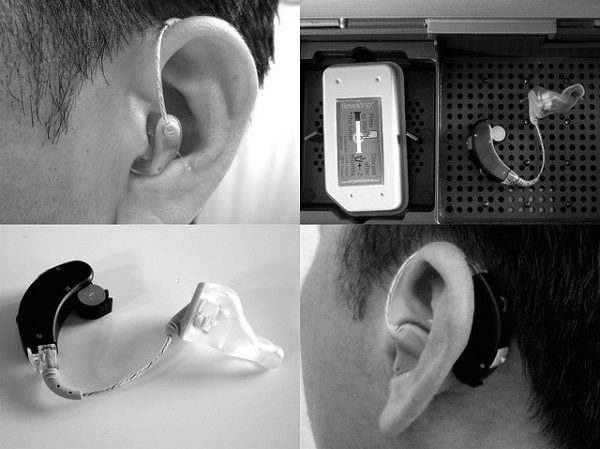The Cost of Being Hearing-Impaired in America

Photo credit: Waifer X, CC BY 2.0.
I’m 29 and have worn hearing aids since I was a teenager. To me, my moderate-to-profound hearing loss feels like a very small part of my identity, but it’s one I’ve been thinking about more than usual, since my current pair of hearing aids has been acting up in the last couple of weeks.
A lot of people don’t know that hearing aids are covered by very few health insurance plans. I often hear, in response: shouldn’t they be covered similarly to eyeglasses? I completely agree — however, most American insurance companies do not share this belief. I tend to blame ageism on their part, and the assumption that while people of all ages can suffer from poor vision, only the elderly are afflicted with hearing loss. This is not only incorrect, but an all-around rough commentary how senior quality of life is viewed.
Being a 20-something with hearing loss has meant many things to me and my everyday life, but the biggest concern for me since entering adulthood has been monetary. Much like most small, delicate electronics, hearing aids tend to have a shelf life of about five years. They get 16 hours of use every day and are exposed to the elements, so their inner workings tend to wear out after a while. The longest I’ve stretched a pair was nearly six years, until I couldn’t stand them abruptly dropping sound quality mid-conversation anymore.
The silver lining is, by the time I need a new pair, the field’s technology has improved by five years, meaning my current set is always my best yet.
Still, the ever-impending cost of a new set has been a large part of my personal finance planning. That doesn’t include the cost of batteries, and everything else that comes with the territory. I’m in the process getting the settings on my current set adjusted, and that added expense has had me thinking of what being hearing impaired has meant for my finances.
Hearing aids: Every five years, I have to drop a couple grand on a new set. I like to tell people it’s like buying two tiny, expensive computers, except they’re way less fun than a MacBook and I need them in order to leave my apartment. With my last set, purchased in 2012, I got a discount through TruHearing, a savings program that partnered with my insurance company. This cut down on total costs, but I still had to pay nearly $2,000 out-of-pocket for my new set of Resound hearing aids. At least they came with a several months’ supply of batteries.
Hearing aid batteries: Speaking of batteries — they’re an ongoing cost. A good sale on size 13 batteries gets me a pack of 16 for $14 at a typical drugstore, but now I buy in bulk online. Last Christmas, one of the gifts my brother and sister-in-law gave me was several packs of my size batteries, and I was slightly embarrassed by how excited I was about it. I used to be bad about planning ahead for batteries, and in college I would often find myself paying more than I should in emergency situations, like when I was traveling and forgot to pack them. Batteries last about 10 days each with my current set, but lately they’ve been fading much faster — hence my current efforts toward getting them properly adjusted.
Adjustments: It can cost between $60 and $150 for an audiologist to change audio settings, clean devices, and change the tubing that connects the hardware to the custom molds made for my ears. I have to admit, I am not great about getting adjustments made, which is probably why mine are in somewhat dire shape right now. I prefer to change my own tubing and clean them with the basic kit they came with, but it’s never as good as when a professional does it. Usually adjustments are free, or at least discounted, with the place from which you buy your hearing aids — however, my guy shut down a year after I bought mine, and now I live in a different city.
Hearing tests/ear specialist appointments: Because I recently moved to a new state and had to find a new audiologist and a new ENT, I decided to do both in one fell swoop. Earlier this week I saw an ear specialist, but I had to get a hearing test done with the audiologist before I could see him. The hearing test (one per year) is covered by my current health insurance plan, but I found out it also calls for a $45 co-pay for seeing a specialist.
Accessories: Want to control your hearing aid volume with your phone? There’s an app for that. However, I’ve never been at a place where I felt I could splurge on any bluetooth accessories. Maybe by 2017, when I’m due for a new pair, I’ll be wildly rich and can afford a $200 wireless tool that connects my hearing aids to my TV and computer.
Aside from recent weeks, being hearing impaired is not usually a huge obstacle for me. I’ve gotten good at lip reading and know basic ASL, and I can follow along just fine in conversations if people are on my better hearing side. As long as I can continue planning for the cost of being hard of hearing, I don’t plan on letting it impact my quality of life.
Meryl Williams is a Chicago journalist who recently moved to Portland. She loves roller derby, upbeat music with depressing lyrics, and shamelessly ordering the Kids Pack-size popcorn at the movies. Sign up for her awesome TinyLetter.
Support The Billfold
The Billfold continues to exist thanks to support from our readers. Help us continue to do our work by making a monthly pledge on Patreon or a one-time-only contribution through PayPal.
Comments